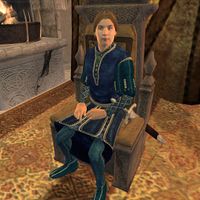Lore:Regulus Terentius
| Count Regulus Terentius | |||
|---|---|---|---|
 Count Regulus Terentius Count Regulus Terentius
|
|||
| Race | Imperial | Gender | Male |
| Born | Third Era |
||
| Resided in | Bravil | ||
| Appears in | Oblivion | ||
Regulus Terentius was the Count of Bravil during the late Third Era. He came from the respectable Terentius family, a noble family that had resided in Bravil since at least the mid-Second Era.[1][2] With an unknown woman he had a son, Gellius.[1]
In his younger days, Terentius was a noted tournament champion.[1][3][4] During this time, the people of Bravil regarded him as a great and kind man.[5] However, by 3E 433, power and idleness had spoiled him, and he was disliked by the residents of Bravil, who had come to regard him as a loafer and philanderer.[1][4][5] The Count's unpopularity can also be attributed to Gellius, who was considered spoiled and was a skooma addict.[1][4][6] Terentius preferred to spend his time engaged in his pastimes instead of ruling County Bravil, so responsibility for his duties fell to his steward, Dro'Nahrahe.[7]
During Terentius' reign, County Bravil was troubled by the Renrijra Krin insurgency, so he appointed Drels Theran as his special inquisitor in charge of suppressing the insurgents.[8] During the Oblivion Crisis of 3E 433, Terentius believed that High Chancellor Ocato planned to use his position as head of the Elder Council to become emperor.[9] When an Oblivion Gate opened outside of Bravil, he put the city guard on high alert and ordered them to hold the walls.[9][10] After the Hero of Kvatch closed the Oblivion Gate, the Count provided military aid for the defense of Bruma.[11]
See Also[edit]
- For game-specific information, see the Oblivion article.
References[edit]
- ^ a b c d e Guide to Bravil — Alessia Ottus
- ^ The Improved Emperor's Guide to Tamriel: Cyrodiil — Flaccus Terentius, 2E 581
- ^ Hans Black-Nail's dialogue in Oblivion
- ^ a b c Antoine Branck's dialogue in Oblivion
- ^ a b Viera Lerus' dialogue in Oblivion
- ^ Aryarie's dialogue in Oblivion
- ^ Dro'Nahrahe's dialogue in Oblivion
- ^ Drels Theran's dialogue in Oblivion
- ^ a b Regulus Terentius' dialogue in Oblivion
- ^ Bravil Guards' dialogue in Oblivion
- ^ Events of Allies for Bruma in Oblivion